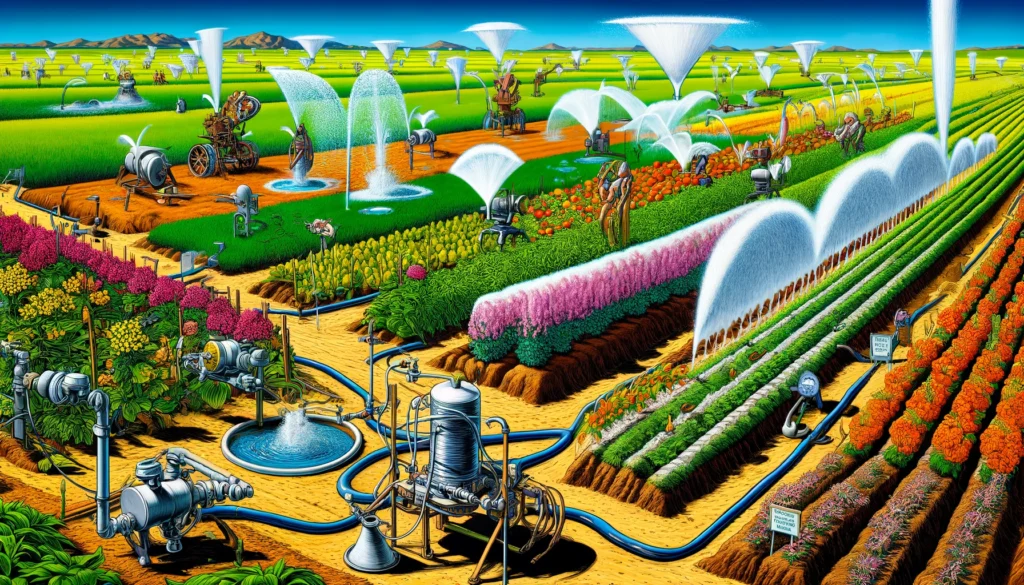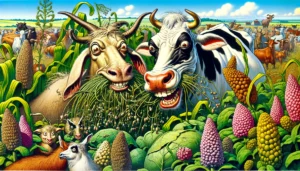
Irrigation methods on a farm A vibrant and detailed illustration in the exaggerated satirical style of Mad Magazine depicting a variety of irrigation methods on a large farm. On 2.webp.webp
Irrigation
Definition:
Irrigation is the artificial application of water to soil or land for the purpose of supplying moisture to crops, plants, and agricultural fields to promote plant growth, enhance crop yields, and sustain agricultural production in regions with inadequate rainfall, drought conditions, or water scarcity. Irrigation systems deliver water efficiently and effectively to agricultural lands through various methods, techniques, and infrastructure to meet crop water requirements and ensure optimal plant health and productivity.
Description:
Irrigation plays a critical role in agriculture by providing supplemental water to crops, maintaining soil moisture levels, supporting plant growth, and mitigating the impacts of drought, aridity, or water stress on agricultural productivity. Irrigation systems vary in complexity, scale, and efficiency, ranging from simple gravity-fed systems and surface irrigation methods to advanced pressurized systems and precision irrigation technologies that deliver water precisely where and when it is needed.
Fall off the barn roof and busted your keister? Life on the farm or ranch can be tough on the bum. Need a break? Laugh it off at FarmerCowboy.com, the #1 farm humor site. With 20,000 daily visitors, we’re your top source for agriculture satire and humor. Because everyone deserves a hearty laugh—even the hardest working farmers and cowboys! Join us and turn those long days into fun tales at FarmerCowboy.com.
Types of Irrigation Systems:
Irrigation systems can be classified into several types based on their design, operation, and water delivery methods, including:
- Surface Irrigation: Methods such as furrow irrigation, flood irrigation, basin irrigation, and border irrigation that apply water directly to the soil surface and allow it to infiltrate and percolate through the root zone of crops, typically used in flat or gently sloping terrain.
- Sprinkler Irrigation: Systems that distribute water over crops in the form of spray or sprinkler droplets using overhead sprinklers, rotating sprinklers, center pivot systems, lateral move systems, or traveling gun systems, suitable for a wide range of crops and field conditions.
- Drip Irrigation: Micro-irrigation systems that deliver water directly to the root zone of plants through drip emitters, drip lines, or micro-sprayers installed near the base of plants, minimizing water losses, soil erosion, and evaporation while maximizing water use efficiency.
- Subsurface Irrigation: Below-ground irrigation methods that deliver water directly to the root zone of plants through buried drip lines, subsurface tubing, or porous pipes installed beneath the soil surface, reducing water losses, soil surface evaporation, and weed growth.
- Center Pivot Irrigation: Circular irrigation systems consisting of rotating sprinklers mounted on wheeled towers that pivot around a central point, delivering water uniformly to crops in circular patterns, commonly used in large-scale field crops such as grains, oilseeds, and forage crops.
- Lateral Move Irrigation: Linear irrigation systems that move laterally across fields on tracks or wheels, delivering water evenly to crops along straight or curved lines, providing flexibility in irrigation scheduling, field layout, and water distribution patterns.
Benefits of Irrigation:
Irrigation offers several benefits to agriculture, including:
- Increased Crop Yields: Enhancing crop growth, development, and productivity by supplying adequate water to crops during critical growth stages, minimizing moisture stress, and optimizing plant-water relationships for maximum yield potential.
- Crop Diversification: Facilitating the cultivation of a wide range of crops, including water-intensive crops, high-value specialty crops, and cash crops, in regions with limited rainfall, enabling farmers to diversify their crop portfolios and increase farm profitability.
- Water Use Efficiency: Improving water use efficiency, irrigation efficiency, and water productivity by delivering water directly to plant roots, reducing water losses, evaporation losses, and runoff losses, and maximizing the effectiveness of irrigation applications.
- Risk Mitigation: Mitigating the risks of crop failure, yield losses, and economic losses associated with drought, erratic rainfall, or water scarcity by providing reliable, consistent, and supplemental water supplies to agricultural fields, ensuring crop resilience and farm viability.
- Seasonal Extension: Extending the growing season, cropping calendar, or agricultural production window by providing water during dry periods, hot spells, or non-growing seasons, allowing for multiple cropping cycles, off-season production, or extended harvests.
- Soil Health: Maintaining soil moisture levels, soil fertility, and soil structure through controlled irrigation practices that prevent soil erosion, nutrient leaching, and soil degradation, preserving soil health and productivity over time.
Conclusion:
Irrigation is a vital component of modern agriculture that enables farmers to sustainably manage water resources, optimize crop production, and ensure food security in regions with limited rainfall or water availability. By adopting efficient irrigation practices, farmers can enhance agricultural productivity, conserve water resources, and promote sustainable water management practices in agriculture.
References:
- Keller, J., & Bliesner, R. D. (1990). Sprinkle and trickle irrigation (Vol. 2). Van Nostrand Reinhold.
- Ward, T. J., & Frederick, J. R. (2002). Agricultural irrigation. CRC Press.
- Lamond, R. E., et al. (2018). Microirrigation for crop production: Design, operation, and management. Elsevier.
Originally posted 2009-11-04 06:11:22.
Originally posted 2024-06-14 04:16:51.
Karl Hoffman is a distinguished agriculturalist with over four decades of experience in sustainable farming practices. He holds a Ph.D. in Agronomy from Cornell University and has made significant contributions as a professor at Iowa State University. Hoffman’s groundbreaking research on integrated pest management and soil health has revolutionized modern agriculture. As a respected farm journalist, his column “Field Notes with Karl Hoffman” and his blog “The Modern Farmer” provide insightful, practical advice to a global audience. Hoffman’s work with the USDA and the United Nations FAO has enhanced food security worldwide. His awards include the USDA’s Distinguished Service Award and the World Food Prize, reflecting his profound impact on agriculture and sustainability.





